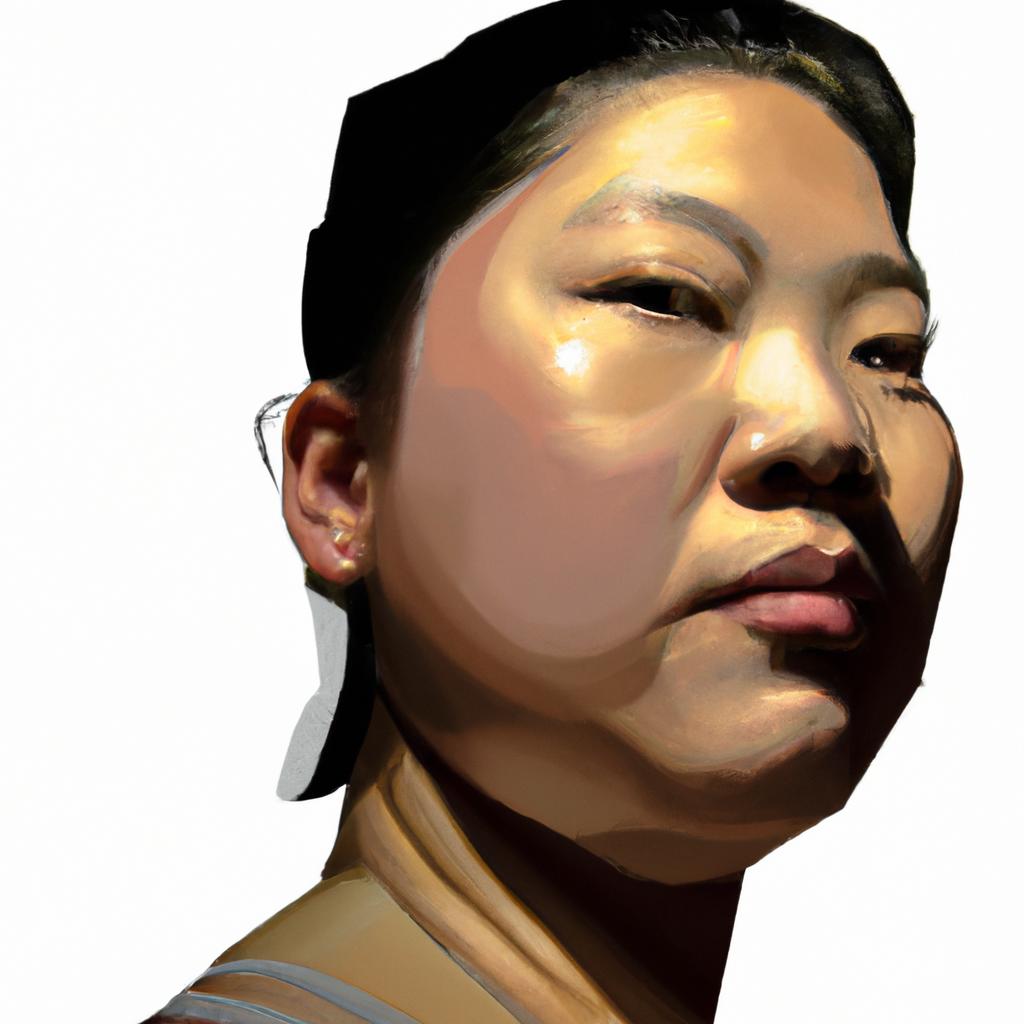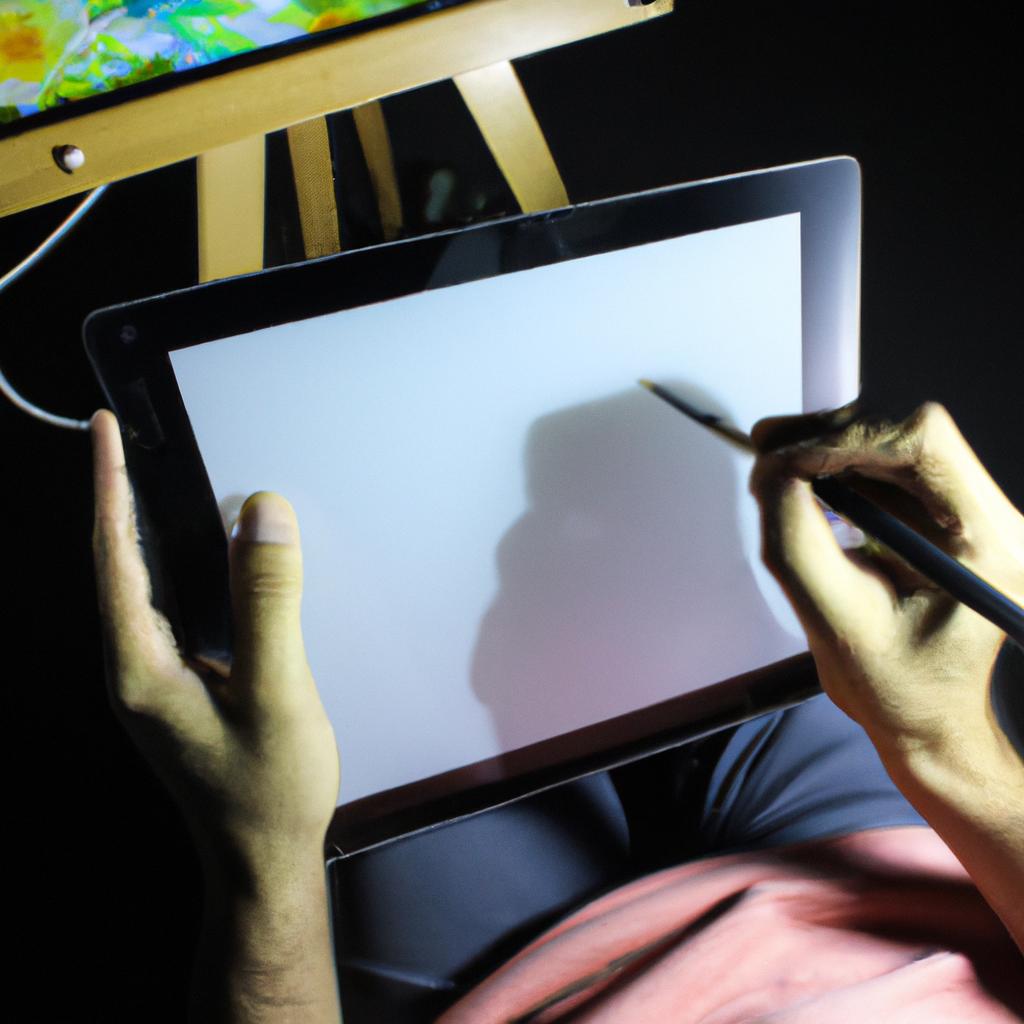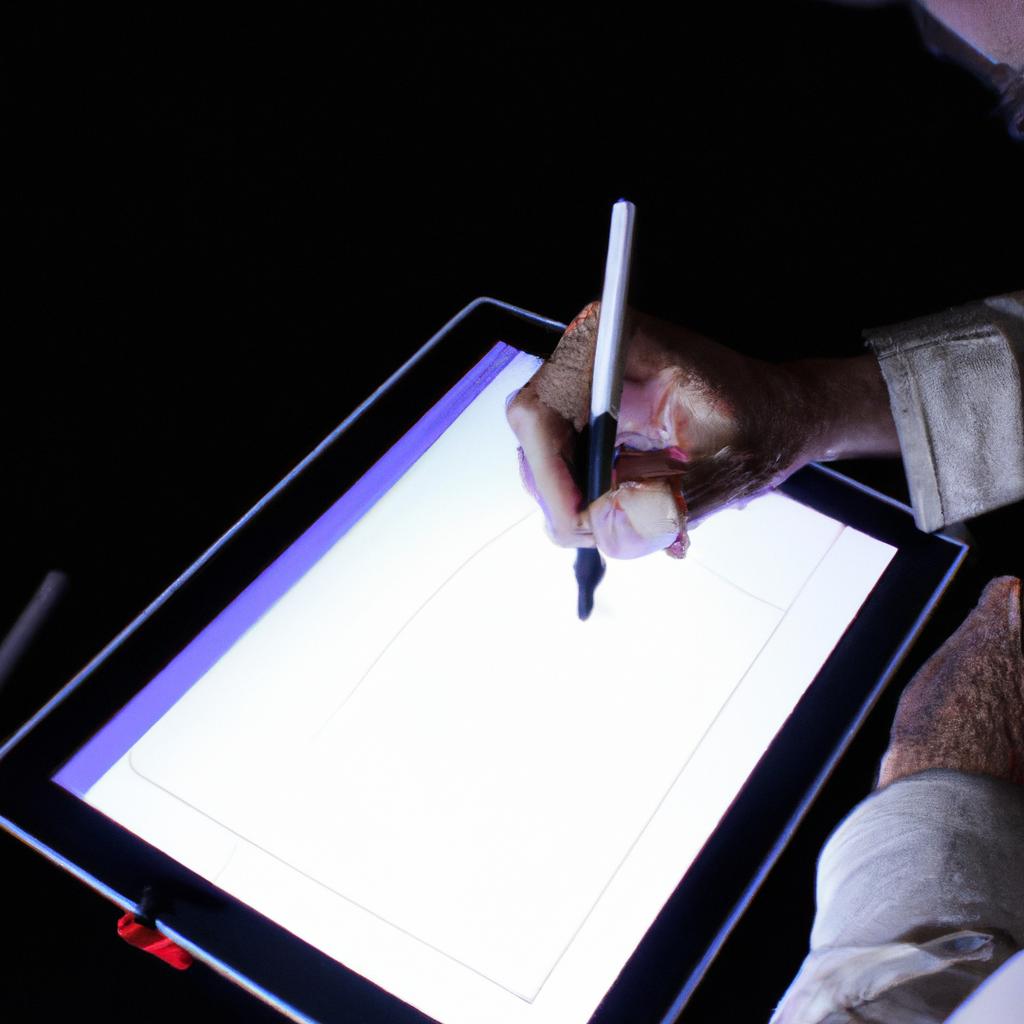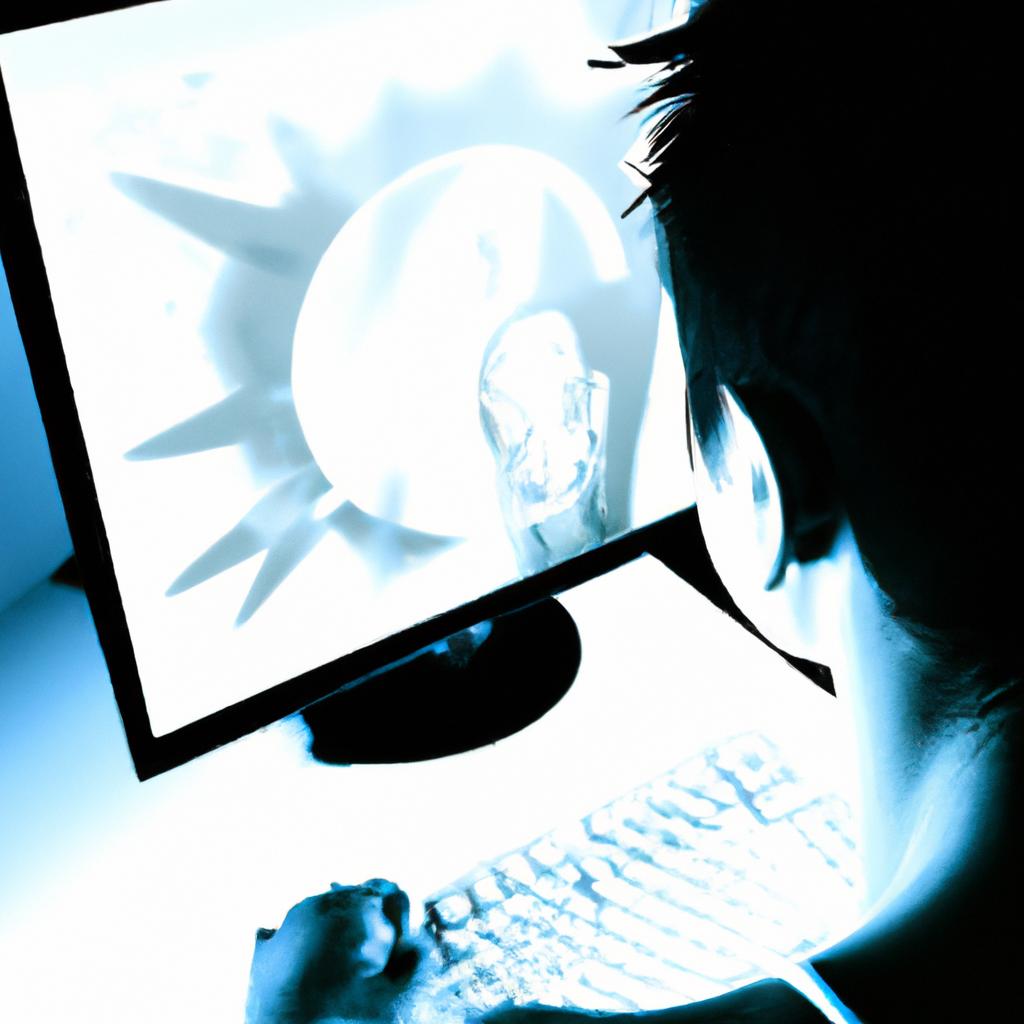Digital painting has revolutionized the field of arts and illustration, providing artists with a vast array of tools and techniques to express their creativity. Among these tools, brush techniques play a crucial role in achieving desired effects and creating visually stunning artworks. This article explores the various brush techniques used in digital painting, examining how they can be applied to enhance artistic expression.
To illustrate the importance of brush techniques, let us consider the hypothetical case study of an aspiring digital artist named Emma. Emma is passionate about creating vibrant illustrations that capture the essence of her subjects. Through experimenting with different brush techniques, she discovers that varying the size, opacity, and pressure sensitivity of her brushes enables her to create depth and texture in her artwork. By using precise strokes for fine details or broad strokes for larger areas, Emma learns how to manipulate brushes effectively to convey emotions and bring life to her creations.
In an academic tone, this article will delve into the fundamentals of brush techniques in digital painting. It will discuss essential concepts such as brush types, settings, and applications—highlighting their significance in producing compelling visuals within the realm of arts and illustration.
Basic Brush Strokes
Basic Brush Strokes
To master the art of digital painting, one must first gain proficiency in basic brush strokes. These fundamental techniques serve as building blocks for more complex and intricate artwork. By understanding and practicing these strokes, artists can achieve greater control over their digital brushes, resulting in improved precision and expressive capabilities.
Consider the example of an artist attempting to depict a serene landscape scene with gentle rolling hills and a calm lake. The artist begins by utilizing the “horizontal stroke” technique to create the foundation of the landscape, smoothly sweeping their brush from left to right across the canvas. This stroke imitates the horizontal expanse of the horizon and provides a sense of tranquility to the composition.
A mastery of basic brush strokes allows artists to convey different textures effectively. For instance, employing short, quick vertical strokes can simulate lush grass or dense foliage within the landscape. Conversely, long diagonal strokes may be used to portray flowing water or cascading waterfall effects. Such variations in stroke length and direction help add depth and realism to artistic creations.
In addition, incorporating various pressure levels while executing brush strokes enables artists to manipulate line thicknesses dynamically. By lightly pressing on their stylus or tablet pen during certain sections of a stroke, they can create delicate lines that evoke fragility or intricacy. Conversely, applying firmer pressure results in bolder lines that convey strength or emphasis.
To summarize:
- Basic brush strokes provide a solid foundation for creating appealing digital artwork.
- Different stroke techniques enable artists to mimic real-life elements such as landscapes and textures.
- Varying pressure levels allow for dynamic manipulation of line thicknesses.
By mastering these foundational skills, artists can elevate their work beyond mere imitation into truly evocative pieces that capture attention and emotion.
Next section: Blending Techniques
Blending Techniques
Imagine you are working on a digital painting of a serene landscape. As you continue to explore the world of brush techniques, it’s time to delve into more advanced methods that will enhance your artwork further. In this section, we will focus on two key aspects: blending techniques and layering with textures.
Blending Techniques:
To achieve seamless transitions and create depth in your digital paintings, mastering blending techniques is essential. One effective method is the “soft brush” technique, which allows for smooth color transitions by gradually merging different shades. Another powerful approach is the “smudge tool,” enabling artists to blend colors together like traditional media such as oil or pastels. Experimenting with these techniques can yield stunning results, bringing life-like realism to your artwork.
Enhancing Textures through Layering:
Layering adds complexity and texture to your digital paintings while maintaining flexibility during editing. By building up layers one upon another, you can simulate various surfaces and materials convincingly. For example, if you want to depict a weathered wooden fencepost in your landscape piece, start with a base layer representing the wood grain pattern. Then add subsequent layers to incorporate details like cracks, moss growth, or peeling paint effect – creating a realistic portrayal of aged wood.
Emotional Response:
Consider how these advanced brush techniques can elevate your artistic expressions:
- Transcend boundaries between imagination and reality
- Infuse emotion and energy into static images
- Evoke nostalgia or evoke awe-inspiring landscapes
- Create visually captivating artworks that leave lasting impressions
Table Example:
| Blending Techniques | Enhancing Textures |
|---|---|
| Soft brush | Layering |
| Smudge tool | Flexibility |
As you progress in exploring advanced brush techniques for digital painting, remember that practice makes perfect. Take time to experiment with different brushes and settings within your chosen software platform until you find the techniques that best suit your artistic vision.
Transition into the Next Section:
With a firm grasp on blending techniques and layering with textures, you are now ready to explore another crucial aspect of digital painting: Layering and Texturing. This next section will delve into methods for adding depth and dimension to your artwork through strategic placement of layers and creative use of textures. Let’s dive in!
Layering and Texturing
Blend Modes
In the previous section, we explored various blending techniques that can be employed in digital painting. Building upon those techniques, this section will focus on layering and texturing to enhance the overall visual appeal of a digital artwork.
Layering serves as a fundamental aspect of creating depth and dimension in digital paintings. By stacking multiple layers with different opacity levels and blend modes, artists are able to achieve complex compositions with varying degrees of transparency and color interactions. For instance, consider a hypothetical case where an artist is working on a landscape painting depicting a serene sunset scene. They may create separate layers for the sky, clouds, mountains, and foreground elements such as trees or buildings. By adjusting the opacity and applying appropriate blend modes to each layer, they can seamlessly integrate these elements into a cohesive composition that conveys depth and atmosphere.
Texturing further enhances the realism and visual richness of digital artworks by simulating tactile surfaces or patterns within the image. Artists often use custom brushes or texture overlays to add details like fur, fabric textures, or weathered effects. These textures not only add visual interest but also evoke emotions associated with certain materials or environments.
To demonstrate how layering and texturing can elevate artistic creations, here is an example:
- The first layer represents a clear blue sky.
- On top of it, another layer is added using a cloud brush set to multiply blend mode at 70% opacity.
- Next, mountains are painted on a separate layer using textured brushes to mimic rough rocky terrain.
- Finally, additional layers are utilized for adding grassy fields and trees using varied brush strokes for realistic effect.
By incorporating these techniques effectively through thoughtful experimentation and practice, artists have numerous opportunities to express their creativity while achieving visually captivating results.
| Layer | Description |
|---|---|
| Sky | Clear blue sky with minimal clouds |
| Clouds | Soft white clouds overlaying the sky |
| Mountains | Rough, rocky mountain range |
| Foreground | Lush green fields and trees |
With the foundations of blending techniques established and the exploration of layering and texturing complete, the next section will delve into creating depth and shadows. This crucial aspect adds a sense of realism to digital paintings by incorporating light sources and their corresponding effects on objects within the composition.
Creating Depth and Shadows
Building upon the layering and texturing techniques discussed earlier, this section focuses on brush techniques that can be employed to add depth and shadows to digital paintings. By using a combination of different brush sizes, opacities, and blending modes, artists can create realistic three-dimensional effects that bring their artwork to life.
To illustrate these techniques, consider a hypothetical landscape painting featuring a majestic mountain range. To emphasize the sense of distance and depth in the composition, an artist might apply the following strategies:
-
Brush Size Variation:
- Use large brushes with soft edges to establish broad areas of light and shadow.
- Gradually decrease the size of the brush as you work towards adding finer details and defining distinct elements within the scene.
-
Opacity and Layering:
- Start with low opacity settings when applying initial washes or base colors to build up layers gradually.
- Increase opacity as needed to intensify highlights or deepen shadows in specific areas.
-
Blending Modes:
- Experiment with different blending modes such as Multiply or Overlay to achieve richer tones and enhance contrast between lights and darks.
- Adjust layer opacity accordingly to retain subtlety while still achieving desired effects.
By employing these brush techniques effectively, artists can create visual depth by manipulating values, textures, and hues. The table below summarizes some key considerations when working with various brush settings:
| Technique | Effect | Application |
|---|---|---|
| Large Brushes | Broad strokes | Establishing overall lighting conditions |
| Small Brushes | Fine details | Defining specific features |
| Low Opacity | Subtle shading | Building up gradual transitions |
| High Opacity | Intense contrasts | Emphasizing focal points |
In conclusion, understanding how to utilize brush techniques is crucial for creating depth and shadows in digital paintings. By varying brush sizes, opacities, and blending modes, artists can effectively manipulate values to achieve a sense of three-dimensionality within their artwork.
Next section: ‘Adding Highlights and Details’, we will explore techniques for incorporating highlights and finer details into your digital paintings using brushes.
Adding Highlights and Details
Creating depth and shadows in digital painting is a crucial skill that can bring life and dimension to artworks. By utilizing various brush techniques, artists are able to add depth perception, create realistic lighting effects, and enhance the overall composition of their illustrations. In this section, we will explore some effective methods for achieving these desired outcomes.
One technique commonly used by digital painters is layering different shades of color to create depth within an artwork. For example, let’s consider a landscape painting depicting a forest scene. By applying darker hues in the foreground and gradually transitioning to lighter tones in the background, artists can mimic the natural effect of objects appearing closer or farther away. This simple yet powerful technique helps establish a sense of distance and spatial relationships within the artwork.
In addition to layering colors, understanding how light interacts with objects is essential for creating believable shadows. Artists often utilize brushes with varying opacities to achieve this effect. By using a softer brush with low opacity, they can delicately add subtle shading to specific areas where shadows would naturally fall. This attention to detail lends credibility to the illustration and enhances its realism.
To further emphasize depth and shadow play in digital paintings, here are some additional techniques:
- Incorporating atmospheric perspective: Using muted colors and reducing contrast as objects recede into the distance.
- Employing chiaroscuro: The dramatic interplay between light and dark highlights form and adds visual interest.
- Experimenting with texture brushes: Applying different brush styles mimics the appearance of various surfaces such as rough rocks or smooth water.
- Utilizing gradient maps: Adjusting color gradients across an image helps create dynamic lighting effects.
The table below showcases examples of different brush techniques employed in digital painting:
| Technique | Description | Example Image |
|---|---|---|
| Blending Brushes | Soften edges for seamless transitions | |
| Texture Brushes | Add depth and realism to surfaces | |
| Splatter Brushes | Create dynamic textures and visual interest | |
| Detailing Brushes | Enhance fine details with precision |
By incorporating these brush techniques, artists can elevate their digital paintings from flat images to captivating works of art that engage the viewer’s emotions.
Special Effects and Brush Customization
Building upon the skill of adding highlights and details, this section will delve into the realm of special effects and brush customization. By exploring these techniques, artists can enhance their digital paintings with unique visual elements that captivate viewers.
To illustrate the impact of special effects, let’s consider a hypothetical scenario. Imagine an artist creating a fantasy landscape featuring a magical waterfall. By utilizing brush customization to emulate flowing water and employing special effects such as glows or particles, the artist can evoke a sense of enchantment within the painting. This example showcases how mastering these techniques can elevate an artwork from mere representation to immersive storytelling.
To achieve compelling results when applying special effects and customizing brushes in digital painting, artists should keep several key factors in mind:
-
Experimentation is Key:
- Artists should explore various settings, textures, patterns, and blending modes to discover new possibilities.
- Embrace trial-and-error approaches to find what works best for different subjects or desired atmospheres.
- Continually refine techniques by seeking inspiration from other artists’ work or attending workshops.
-
Attention to Detail:
- Small adjustments like brush opacity or size variations can make significant differences in achieving desired effects.
- Focusing on intricate detailing enhances realism while maintaining artistic expression.
- Precision contributes to cohesive compositions by ensuring consistency throughout the piece.
-
Understanding Color Theory:
- Knowledge of color harmonies enables artists to create visually pleasing combinations that evoke specific emotions.
- Utilize contrasting colors for emphasis or complementary shades for seamless integration.
- Awareness of color psychology facilitates effective storytelling through intentional use of hues.
By considering these aspects along with personal style preferences, artists can unleash their creativity while leveraging technological advantages offered by digital tools. The following table exemplifies some popular brush customization options and potential special effects that artists can employ:
| Brush Customization | Special Effects |
|---|---|
| Texture and Pattern | Glows |
| Opacity Variations | Particles |
| Size Adjustments | Motion Blur |
| Blending Modes | Lighting Effects |
Incorporating these techniques into their artistic practice, digital painters have endless possibilities to create captivating artwork that engages viewers on both an emotional and aesthetic level.
 PSP Oste
PSP Oste



